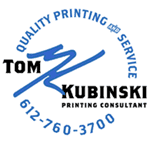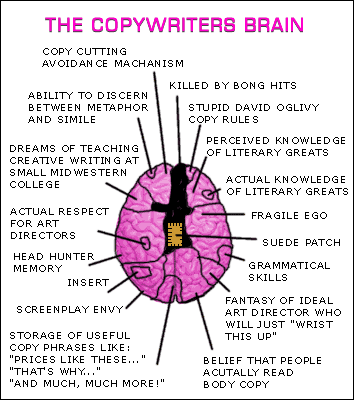

Tom Kubinski
Printing Consultant
tkubinski@sextonprinting.com
Direct: (651) 255-1225
Fax: (651) 457-7040
Cell: (612) 760-3700

 Mary Albers
Customer Service
mkc@sextonprinting.com
Direct: (651) 255-1255


 www.sextonprinting.com
250 East Lothenbach Ave.
Saint Paul, MN 55118
Phone: (651) 457-9255
Fax: (651) 457-7040
Toll Free: (800) 388-2914

Branding - 22 Laws Of
Brand Warfare
Creative Coatings Techniques
Desktop Techniques
Digital / Variable Printing
Direct Mail Raise Response, Lower Costs
Duotones-Tritones-Quadtones
FSC Certification
In House Mailing Capabilities
Ink Tour
Paper Mill Tour
Picking the Right Paper
PDF Formats
PDF Info & Quark vs. InDesign
Postal Increases & Requirement Changes
Post it to the Web vs. Print
Press Check Tips
Save Disk Space
Top File Issues
UV Burn
Ways to Save Money
What Sets Sexton Apart?
Why Work With TK?
|
 |
April 2005 TK's Korner
Direct Mail-How to Make it Stand Out
Many of you are either currently involved in some form of a direct mail campaign or are
considering one. No matter which is the case, the most commonly asked questions are:
- What can I do to make the best impression?
- How can I ensure my mail stands out from the rest?
- What are the critical elements that I should consider?
Those are excellent questions and in this issue of TK's Korner, I'll attempt to give you some helpful suggestions and info.
 First, you must understand / know your Target Market in order for you to create and design an offer that gets noticed or acted upon. Who/what is your target market as it pertains to:
First, you must understand / know your Target Market in order for you to create and design an offer that gets noticed or acted upon. Who/what is your target market as it pertains to:
- Gender
- Age
- Inco
me
- Location
- Hobbies
- Industry
- Buying objectives
- Likes
- Dislikes
- Life buying history
- etc.
The more specific your target, the better use of your marketing dollars and hopefully the bigger ROI will be. A mail list company can assist you in obtaining this data. If you need some sources, please give Tom Kubinski a call at 651-255-1225. Also, you may consider some type of test market to be done before launching the whole campaign.
Some things to consider:
Competition-You'll need to answer the following in order to compete:
- Who are they
- What are they offering
- Who are they trying to reach
- How are they trying to reach their targets
- How often are they contacting them
- How will their offer compete with yours
- What ideas can you use and improve on
Your Product / Offer-here you'll need to figure out
- What are you selling/offering
- What's special about your product
- What makes yours stand out from the rest in capabilities, benefits, look, design etc
- What will it do for your target market-write out in short and focused sentences on the benefits/comparisons
Once you have clearly defined your target audience, understand their demographics and psychographics, have done research on your competition and clearly defined your offer, you are now ready to start the process
of creating something that stands out from the rest.
Copy & Design-develop a design profile that can serve as a guide. One that the sense of style matches those of your target audience and specific image of your company. Keep in mind that you'll want to cover it in a less is more approach by telling them:
- Who you are
- What do you do
- Who do you cater to
- What can you do for them
- Where are you located
- Call to Action-state your offer in every element of your package, define what you want them to do and repeat your call to action several times
- Make it Easy for them to Respond-If you want to sell them something, make it easy to order. If you want them to go to a specific page on your web site, make it easy for them to click and go there. Also include how they can contact you.
Keep in mind that the average person sorts their mail in the following manner (see if you do the same tonight):
- Uncoated stock with 1color or 2color-is typically considered junk mail and gets filed into the waist basket with very little review time. Note real estate agents are known for this and you're likely to recall the company, but not the agent.
- Bills-are set aside into one of two piles and is usually placed onto an area to be dealt with at a later time-when absolutely necessary.
- Odd Size, Glossy stock with 4color pr
inting or other techniques-are placed into the other pile. This pile is picked through first usually going to the biggest or odd size piece with nice, big and colorful images. If the images capture their interest, then they read the headers. If the headers grab them, then they read the bullets. If the bullets cause a spark, then they read the copy. Again, less is more, don't give them the store. Give them just enough to drive them to learn more, to get more details, to call to action or contact your team in order to set an appointment or close the deal.
With that in mind, your design will now be able to be put together. Listed below are a few vehicles that you may consider for delivering your message along with very ball park postage considerations:
Postcards
minimum=3.5x5 on 7pt stock @ **
maximum=4.25x6 on 7 pt stock @ ** |
Postage-ballparks only Days to process
1st Class=.24-.30----2 to 7 days
Pre Sort Stnd=.21-.24--5 to 15 days
Not Profit- =.14-.20--5 to 15 days |
BRC
minimum=3.5x5 on 7pt stock
maximum=4.25x6 on 7pt |
1st Class=.24 plus handling |
Letter
minimum=3.5x5 on 7pt
maximum=6.125x11.5 on 9pt |
1st Class=.39------2 to 4 days
Presort Stnd=.24-5 to 15 days |
Flat
minimum=6.125x11.5
maximum=12x15
|
Postage depends on size, rate and method of delivery |
Note that postage will b
e affected by your size and weight of piece. There are Length divided by Height ratios that must be considered. If have questions, please call Tom Kubinski @ 651-255-1225, visit TK's Korner issue December 2003-In House Mailing Capabilities, call the Post Office Mail Piece Design @ 1-612-349-4945, Post Office Regulations @ 612-349-4747 or visit the USPS web site by going to TK's Korners issue November 2003-Mailing Requirements-Update & Links. As always, it is a good idea to have your design checked out by the USPS Mail Piece Design before printing.
|
@ | NOTE that 7pt is the minimum. You may choose to go with 9pt, which costs a little bit more in paper, yet you could earn additional postage discounts. Also, if the size is > 4.25x6, must be on 9pt to avoid surcharges. |
| ** | NOTE Postcard layouts-to be able to earn postal discounts please keep the following in mind. |
- Left Hand Corne
r-top third is for return address info. Very important, since the postal reader machine reads from left to right, you must not have any specific address info below the top third. IE if seminar location address is added, chance of having all the cards sent to that address is quite high. Keep address generic. Example; Minneapolis Hyatt Regency on Lyndale would be good. Also, keep 1/8 inch on left side clear of any print for postal machines is recommended.
- Middle to Right-keep 2.125 clear of any print to qualify for the Postcard rate. If printing is in this area, will not qualify for Postcard rate. It will then be considered the letter rate.
- Right Hand Corner Top-minimum Permit box size is 1/2x1/2 and about 1Ú4 down from top and over from right. Type should be 4pt all caps minimum.
- Right Hand Corner Middle-leave an area from the right edge towards middle of 1.5x3.375 for the address block
- Right Hand Corner Bottom to Left-leave an area of 5/8 up from bottom and 4.75 from right to left of card for a bar code to be added for automation postal discounts if applicable.
Images
- Big, Colorful, Eye
tching and different in some manner
- The use of techniques like spot coatings, foils etc to highlight specific areas
- Black and White images can be used along with 4color to show a negative situation in B/W with the positive/solution in a 4color
- Since it is going through the mail, coatings to protect the piece are highly recommended
Some TK's Korner issues that may assist you with this section are:
- Duotones, Tri-Tones, CMYK Quad-tones
- Creative Coating Techniques
- Using Desktop Techniques to Your Advantage
- Picking the Right Paper
Food for Thought:
Repetition is the mother of recognition or learning. Thus, the more often you hit the target market with different and creative pieces, the better chance of having them recognize and purchase/act on your offer. I've had huge success with my clients by creating a whole program at one time and printing them to earn economies of scale. We also can leave the backs blank in order to gain flexibility with customization as each card goes out. Bottom line, we now have a program that is cost effective, versatile and allows them to hit their target market as often as they want.
Research/Data:
2005 Strategies for Management, Inc used DMA data to calculate revenue per pro
motion dollar spent in the various types of media:
| Media | Estimate of Revenue Per Dollar Spent |
| Direct Mail | $20.29 |
| Telephone | 18.15 |
| E Mail | 16.0 |
| Dimensional Mail-Samples/Give A ways | 15.50 |
| Newspaper | 9.0 |
| Coupons | 6.52 |
| Inserts | 3.50 |
| Catalogs | 2.14 |
| Magazines | 2.0 |
| Free Standing Newspaper Inserts | 1.71 |
| Radio | 1.14 |
| Direct Response TV-Info Mercials | .67 |
Sappi Fine Paper North America's "Life With Print" industry research through 11 sources fou
nd the following:
- Method of contact preferred by consumers: Regular Mail=76%, E Mail=8%, Telephone=7%, In Person Visit=6%, No Answer=3%
- Percentage of sales from paper catalogs vs. website: Catalogs=80%, Website=20%
- "Take full advantage of what print has to offer as a medium. As a sales device. Because direct mail works"
- "Consumers with higher level of incomes purchase more often by mail"
- "Consumers have catalogs in hand when buying on line. Half of those that browsed in a catalog and purchased on line (53%women & 38% men) used a product code form the catalog"
- "But print likes company. When there is a mix with integrated message, print makes that message even stronger. Data shows that a marketing program combining print and TV almost always out performs one that relies on TV alone"
- "What about the impact of E Commerce? Successful marketers are finding that print and internet aren't competitors at all. Rather, they can be the perfect compliment to one another. For instance, printed catalogs can drive consumers to a web site to make the actual purchase."
- "What's their advantage over electronic media? People can hold them, touch them. And catalogs and direct mail will touch people right back"
- "The worldwide evidence is mounting that print media deserves to be a core element of marketing plans."
- "Two central messages which
emerge are that print is a very effective medium when used on its own: and that employing a combination of print and TV nearly always outperforms TV only policy"
- "The clear lesson is that brands which increase or maintain their advertising in a recession tend to achieve improved market share and return on investment when the recover occurs."
I hope this issue has been helpful in letting you know more about Direct Mail, what you can do to make the best impression, how you can ensure you mail stands out from the rest and what critical elements you should consider. If you would like more information for your next printed project, to see some of the really cool samples I have or regarding this article, please give Tom Kubinski a call @ 651-255-1225.
~ Portions of this document were obtained from McKay Envelope Company-Envelope Matters.
Referrals are greatly appreciated. If you know someone who I should contact, please let me know.
If you would like to join me on one of our upcoming tours, if there is something that you would like me to address, or if you know of someone who might like to receive TK's Korner, please let me know via e-mail at tkubinski@sextonprinting.com or phone. Take care and have a great day.
Successfully,
 Tom Kubinski-Printing Consultant Tom Kubinski-Printing Consultant |




 First, you must understand / know your Target Market in order for you to create and design an offer that gets noticed or acted upon. Who/what is your target market as it pertains to:
First, you must understand / know your Target Market in order for you to create and design an offer that gets noticed or acted upon. Who/what is your target market as it pertains to: